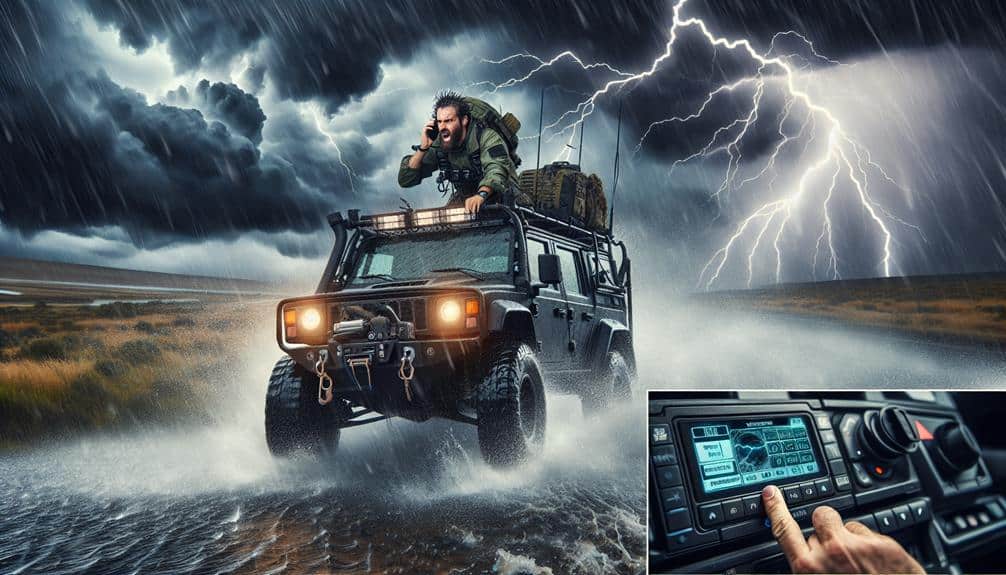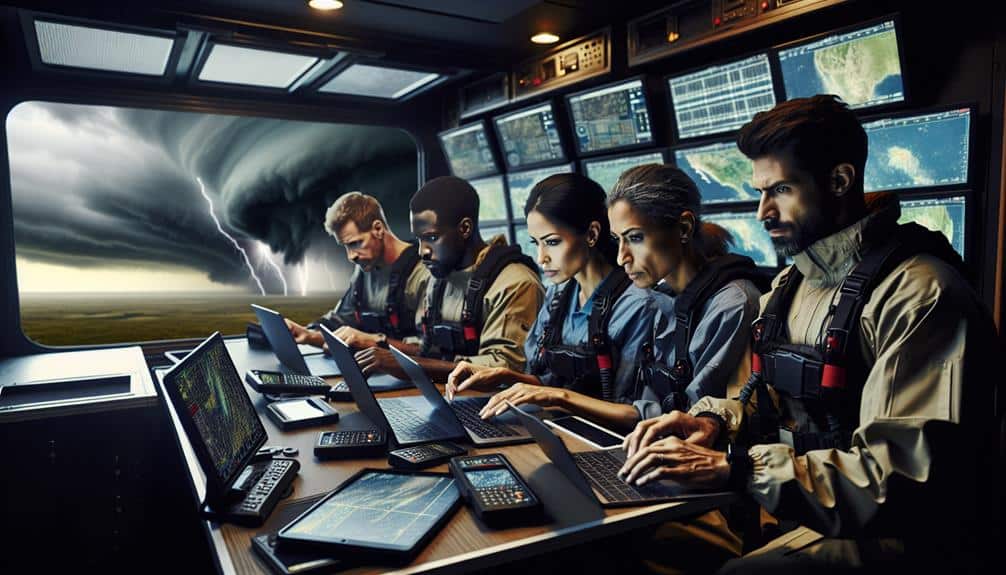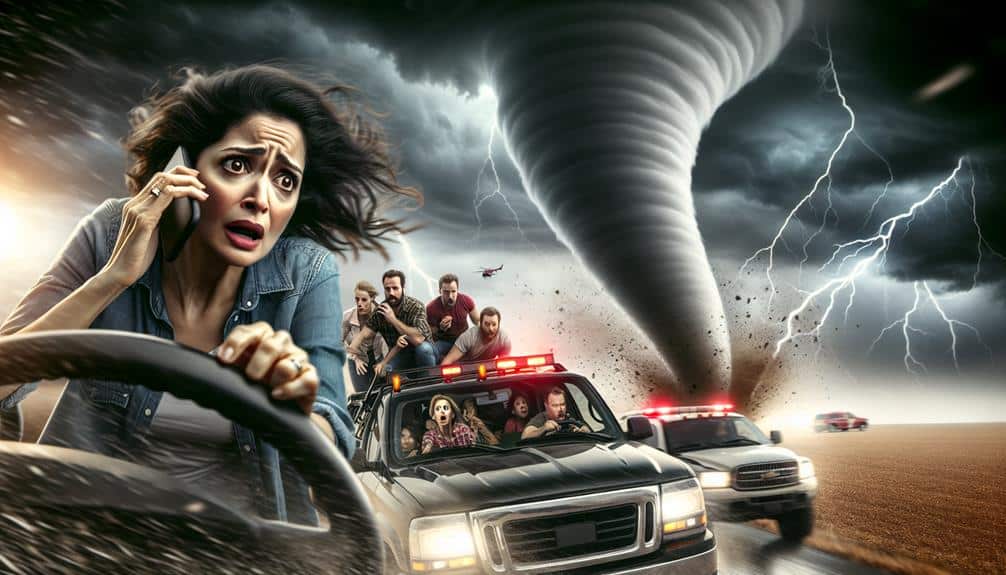To maximize safety during storm chasing missions, we need to use dependable weather monitoring tools and maintain rigorous equipment checks. Our vehicles should have strengthened windows, first aid kits, and emergency supplies. We plan routes with proximity to shelters and multiple evacuation options in mind, constantly reassessing as storms evolve. Proficiency in weather forecasting and atmospheric analysis is vital. Clear team roles, consistent communication, and well-defined safety protocols are necessary. Analyzing real-time data with Doppler radar and guaranteeing backup communication plans further safeguard our missions. By following these guidelines, we ensure thorough preparedness and best risk management for storm chasing.
Key Points
- Regularly maintain and inspect all weather monitoring and communication equipment for optimal performance.
- Equip vehicles with reinforced windows, emergency supplies, first aid kits, and ensure routine inspections for tires and engines.
- Master and continually apply weather forecasting, storm tracking, and atmospheric analysis techniques.
- Establish clear team roles, maintain constant communication, and implement emergency contact and backup communication protocols.
Choosing the Right Equipment
Choosing the correct equipment for storm chasing is vital to ensure both safety and data accuracy. We need to focus on proper gear selection and equipment maintenance to optimize our tools functionally under extreme conditions.
First, we must choose reliable weather monitoring devices, such as portable weather stations and barometers. These instruments provide real-time data on temperature, humidity, and pressure, which are essential for predicting storm behavior.
In addition to weather monitoring, communication devices are crucial. Equipping ourselves with satellite phones, two-way radios, and GPS trackers ensures we stay connected with our team and emergency services, even in remote areas. Regular maintenance of these devices can't be overlooked; we must frequently check batteries, software updates, and signal strength to avoid potential failures.
Proper gear selection doesn't stop at monitoring and communication equipment. We need to equip our vehicles with reinforced windows, first aid kits, and emergency supplies. Tires and engines should undergo routine inspections to handle the rigorous conditions of storm chasing.
Identifying Safe Locations
Ensuring our safety during storm chasing missions extends beyond equipment selection to carefully identifying safe locations where we can observe and gather data without putting ourselves at unnecessary risk. Strategic positioning is essential; we need to find vantage points that provide clear visibility of the storm while minimizing exposure to hazards.
This involves conducting thorough risk assessments to anticipate potential threats.
Key considerations for identifying safe locations include:
- Proximity to emergency shelters: We should always be aware of nearby structures that can provide shelter if conditions worsen unexpectedly.
- Availability of evacuation routes: Ensuring multiple clear paths for quick departure allows us to adapt to rapidly changing situations without hesitation.
We must stay vigilant and continuously reassess our positioning as the storm evolves. By incorporating these safety measures into our planning, we can balance the thrill of storm chasing with the necessity of safety.
Our freedom to explore and study these natural phenomena hinges on meticulous preparation and an unwavering commitment to safety.
Understanding Weather Patterns
Understanding weather patterns is vital for us to predict storm behavior and make informed decisions during our missions. By mastering weather forecasting and storm tracking, we gain the ability to anticipate storm development and navigate safely.
We analyze atmospheric conditions meticulously, focusing on variables like temperature, humidity, and air pressure. These factors interact to create the complex systems that give rise to severe weather.
Wind patterns play an important role in our analysis. By studying the speed and direction of winds at different altitudes, we can predict storm movement and intensity. For instance, strong upper-level winds can indicate the potential for tornado formation.
We use radar and satellite data to track these patterns in real-time, which allows us to adjust our position proactively.
Our primary tools include Doppler radar, which provides detailed information on wind speed and direction, and advanced computer models that simulate weather scenarios. These technologies enable us to visualize storm trajectories and make split-second decisions.
Effective Team Coordination
While mastering weather patterns equips us with the knowledge to predict storm behavior, effective team coordination guarantees our actions are synchronized and precise during missions. We can't afford missteps when navigating high-risk environments.
By leveraging communication strategies and thorough risk assessment, we enhance our operational efficiency.
Effective communication strategies are pivotal. We rely on:
- Real-time updates: Constant information flow via radios or mobile apps ensures everyone is aware of the latest weather conditions and positional changes.
- Clear role definitions: Assigning specific tasks to each team member minimizes confusion and maximizes efficiency.
Risk assessment is another critical component. We evaluate potential hazards continuously, adapting our plans to mitigate dangers. This includes analyzing storm trajectories, road conditions, and potential escape routes. We must be agile, able to pivot based on the evolving situation.
Emergency Contact Protocols

Having strong emergency contact procedures in place is crucial for maintaining safety and coordination during storm chasing missions. We need to make sure that all team members have up-to-date contact information for each other and for emergency services. This allows us to respond promptly and effectively if something goes wrong.
Our procedures must include a detailed list of local emergency response numbers for the areas we'll be chasing in. Each team member should have these numbers saved and be familiar with the procedures for contacting local authorities. In addition, we should designate a primary contact person who'll be responsible for coordinating emergency responses and relaying critical information to the rest of the team.
We also need to establish a check-in system where team members regularly communicate their status and location. This can be done through scheduled radio calls or digital messaging systems. By making sure that everyone checks in at pre-determined intervals, we can quickly identify if someone is in trouble and needs assistance.
Lastly, let's not forget the importance of having a backup contact protocol in place. If the primary contact person becomes unreachable, having an alternate ensures that communication lines remain open and efficient.
Real-time Data Monitoring
Efficient storm chasing demands us to constantly monitor real-time data to make informed decisions and safeguard our safety. We rely heavily on advanced technology to stay ahead of rapidly changing weather conditions. By leveraging weather radar and satellite imagery, we can accurately track storm movements and intensity.
Using weather radar, we can pinpoint precipitation patterns, detect rotation within storm cells, and anticipate potential tornado formations. This real-time insight enables us to adjust our routes and avoid hazardous areas.
Satellite imagery offers a broader perspective, helping us visualize cloud formations and monitor storm development over large regions.
To make sure we're making the best decisions, we integrate multiple data sources into our monitoring process:
- Weather radar: Provides real-time updates on precipitation and storm structure.
- Satellite imagery: Offers extensive views of cloud cover and storm evolution.
Post-mission Safety Review

After each storm chasing expedition, we need to conduct a comprehensive post-mission safety review.
This involves evaluating team performance to identify any procedural gaps and appraising the condition of our equipment to verify it remains operational.
Evaluating Team Performance
Our team's post-mission safety review focuses on systematically analyzing each aspect of the storm chase to identify areas for improvement. We emphasize evaluating team performance through precise metrics and detailed analysis. Effective team communication and thorough risk evaluation are paramount to our mission's success.
First, we appraise our communication protocols. How well did we relay critical information? Did our updates guarantee everyone was informed and coordinated?
Next, we scrutinize our risk evaluation process. Were hazards identified and mitigated promptly? Did we adapt effectively to evolving storm conditions?
By evaluating these areas, we aim to enhance our operational efficiency and safety. Key points of analysis include:
- Communication Effectiveness: Examining the clarity and timeliness of our internal communications.
- Risk Management: Reviewing how risks were identified, assessed, and managed during the chase.
Our methodology is technical, yet it empowers us with the freedom to adapt and improve. By rigorously evaluating our performance, we ensure that each mission is safer and more efficient than the last.
This systematic approach allows us to continually refine our strategies, enhancing both safety and success in future storm chases.
Equipment Condition Assessment
We systematically inspect each piece of equipment post-mission to make certain that every component remains in optimal working condition. Our maintenance checklist is comprehensive, covering everything from vehicle engines to communication devices. By adhering to this checklist, we can identify any wear and tear that might compromise equipment reliability in future missions.
Safety precautions are paramount during our inspections. We use protective gear when handling electrical components and verify that all machinery is deactivated before we begin. This minimizes the risk of injury and further damage to the equipment.
A key part of our post-mission review involves conducting a detailed risk assessment. We evaluate the potential consequences of equipment failure and prioritize repairs based on the severity of these risks. By doing so, we guarantee that our gear is always ready to withstand the extreme conditions we face during storm chasing.
Regular equipment assessments aren't just about fixing what's broken; they're also about preventive maintenance. This proactive approach helps us maintain high levels of equipment reliability, allowing us to perform our missions safely and effectively. We're committed to making sure our tools are always in excellent condition, ensuring our freedom to chase storms safely and confidently.
Frequently Asked Questions
What Are the Mental Health Considerations for Storm Chasers?
Have we considered the importance of stress management and coping strategies? We must prioritize mental health, ensuring our team handles the emotional toll effectively. This approach maintains our resilience and freedom to pursue our storm-chasing passion.
How Can Storm Chasers Maintain Physical Fitness for Missions?
To maintain physical fitness for missions, we should focus on rigorous physical training and meticulous nutrition planning. Strengthening core muscles and ensuring balanced diets will enhance endurance and agility, essential for our demanding and unpredictable expeditions.
What Are the Insurance Options for Storm Chasers?
Just as Odysseus needed protection for his journey, we need the right coverage options. Exploring policy requirements, premium rates, and the claim process gives us the freedom to chase storms while ensuring we're financially safeguarded.
How Do Storm Chasers Manage Long-Term Career Sustainability?
We manage career longevity and stress management through rigorous health and fitness maintenance. By prioritizing physical conditioning and mental well-being, we guarantee sustained performance and resilience, crucial for long-term success in this demanding field.
What Training Is Needed for Handling Hazardous Materials During Storm Chases?
When we're storm chasing, Hazmat training guarantees we handle hazardous materials safely. We follow strict safety protocols, like knights in a modern quest, to protect ourselves and the environment, securing our freedom to explore remains uncompromised.


